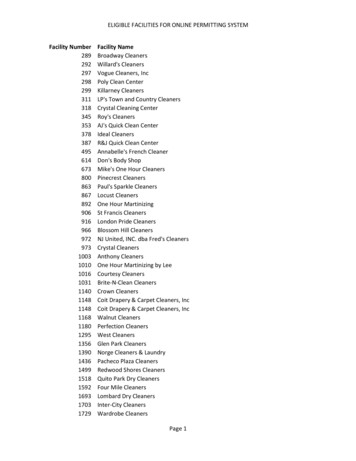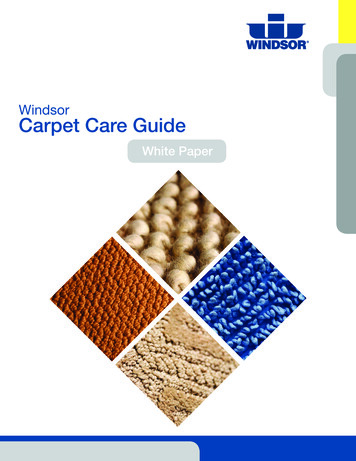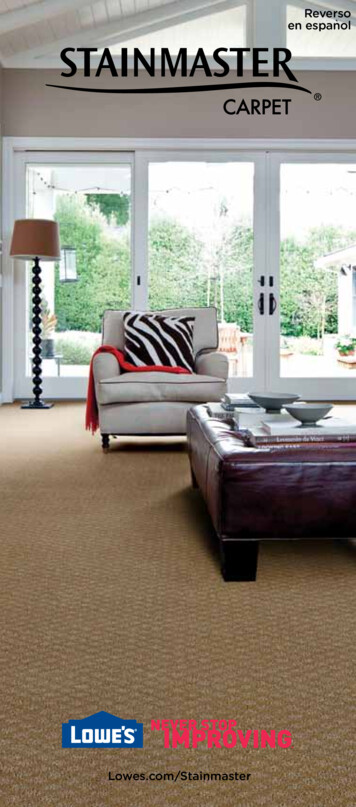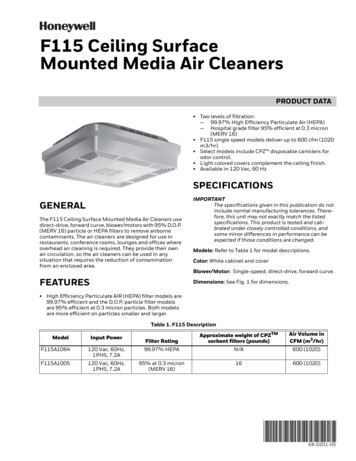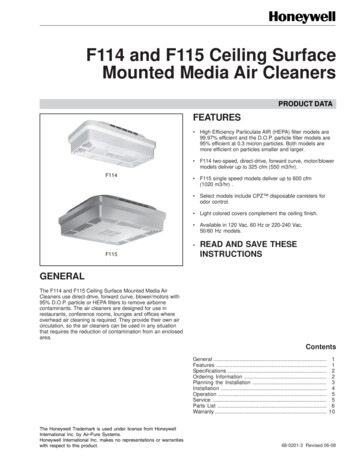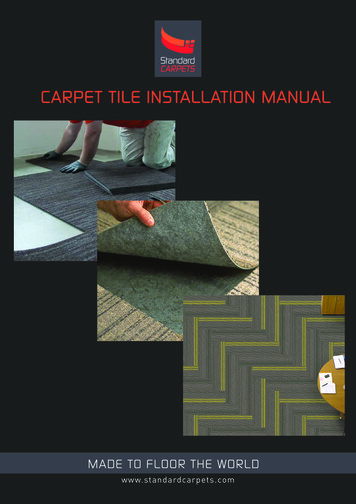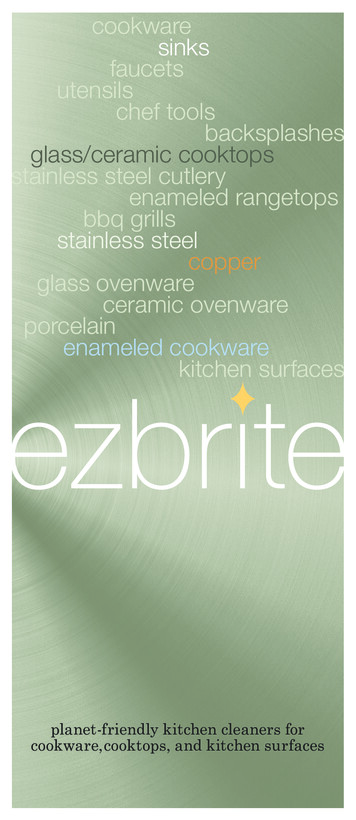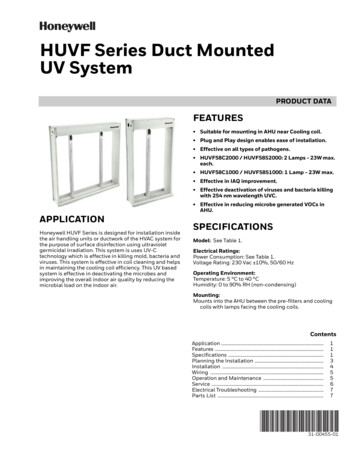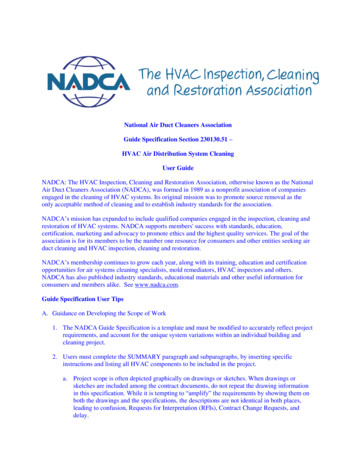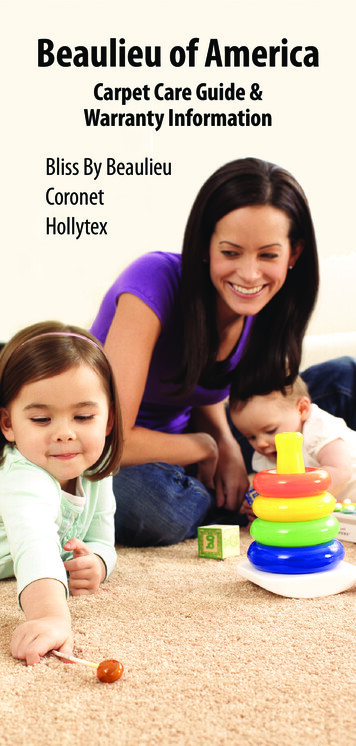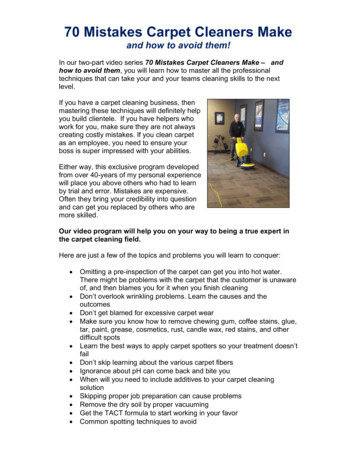
Transcription
70 Mistakes Carpet Cleaners Makeand how to avoid them!In our two-part video series 70 Mistakes Carpet Cleaners Make – andhow to avoid them, you will learn how to master all the professionaltechniques that can take your and your teams cleaning skills to the nextlevel.If you have a carpet cleaning business, thenmastering these techniques will definitely helpyou build clientele. If you have helpers whowork for you, make sure they are not alwayscreating costly mistakes. If you clean carpetas an employee, you need to ensure yourboss is super impressed with your abilities.Either way, this exclusive program developedfrom over 40-years of my personal experiencewill place you above others who had to learnby trial and error. Mistakes are expensive.Often they bring your credibility into questionand can get you replaced by others who aremore skilled.Our video program will help you on your way to being a true expert inthe carpet cleaning field.Here are just a few of the topics and problems you will learn to conquer: Omitting a pre-inspection of the carpet can get you into hot water.There might be problems with the carpet that the customer is unawareof, and then blames you for it when you finish cleaningDon’t overlook wrinkling problems. Learn the causes and theoutcomesDon’t get blamed for excessive carpet wearMake sure you know how to remove chewing gum, coffee stains, glue,tar, paint, grease, cosmetics, rust, candle wax, red stains, and otherdifficult spotsLearn the best ways to apply carpet spotters so your treatment doesn’tfailDon’t skip learning about the various carpet fibersIgnorance about pH can come back and bite youWhen will you need to include additives to your carpet cleaningsolutionSkipping proper job preparation can cause problemsRemove the dry soil by proper vacuumingGet the TACT formula to start working in your favorCommon spotting techniques to avoid
Dozens of things to master with lowmoisture cleaningDon’t make these common chemistrymistakesKnowing when a pre-scrub is requiredThe Dos and Don’ts of wand strokesHow to adjust the chemical mix for any jobCorrect these mistakes made whenrunning a self-contained extractorDon’t forget to monitor recovery ratesPreventing and correcting browningRotary extraction techniques to improvequality and productivityIn total you will learn how to prevent or correct 70 mistakes that carpetcleaners make.These are all critical mistakes that could ruinany job, so make sure your helpers are fullytrained. If you are working for someone else,this program will help accelerate yourcleaning skills.And, if you own a carpet business, make sureyour competition doesn’t get a head start onlanding new accounts. Especially whendifficult carpet was not previously cleaned tothe customer’s satisfaction.If you want to take youroperations to the next level,you need to invest in thistraining today.Your choice: eversion downloadedto your computer where you canmake your own backups and printout the manuals, or you can orderthe download version plus thehardcopies mailed to you.Here are all the products you will receive in thisexclusive carpet care training bundle -
IICRC approved Basic Skills CarpetCleaning program including IICRCdiploma. Package contains 100-page manual and twoslide shows. Student versions of the IICRC program are alsoavailable without the slide shows and videos.Ideal for classroom training with severalstudents.Start or Expand a Carpet CleaningBusiness 250 power packed pages on marketing,bidding, administration and comprehensivetraining to grow your business. Learn all the inside tips on starting or growinga successful carpet cleaning business.Cleaning Managers Dashboard A unique series of 40 spreadsheets that help yourun your entire cleaning business.Shows how to import a free database for any zipcode to use for direct mail, telemarketing orcanvassing.Helps with startup cost projections, tracking theeffectiveness of all marketing strategies, andcomplete follow-up plans.Sharpens your bidding skillsProvides work orders, invoices, scheduling,supply tracking, payroll, taxes, budgets, accountretention strategies, KPI, P&L reports and selfrating evaluation of all management duties.Detailing Upholstery Master the understanding of soil composition, the fundamentals ofcleaning, maintaining indoor air quality, pH adjustments and working withstain destratification. Covers:
9 topics about supplies and equipment,11 topics about successful spot removalTips on deodorizing, drying, protectants anddiagnostic checks for hot water extractorsCleaning Performance Handbook 250-power packed pages of how to best train andmotivate cleaning workers.Contains over 35 strategies and programs toimplement new skills and improve quality.)Exclusive CPR (Cleaning Performance Rating)program adjusts quality and productivity rating foreach worker and building (levels the playing field).Innovative In-Service Training Lessons. Forty-fiveways to supercharge your training program.Twenty-eight strategies to improve cleaningproductivity.Over 120 tips on solving difficult cleaningproblems.Over 30 strategies to solve performanceproblems.Ten mistakes to avoid in cleaning carpets.Ten mistakes to avoid in stripping and finishing floors.Twenty-seven coaching skills that boost team performance.70 Mistakes Carpet Cleaners Make – and how to avoid themTwo videos with over one hour in critical trainingCarpet Training Bundle – as shown aboveNormal Download eversion price 564On sale today 359.00Price for eversion plus hardcopy mailed out 734 Now 459.00More details below:
IICRC Basic Skills Carpet Care TrainingCarpet Care Strategies you will Master: Soil prevention measures that reduce cleaningfrequencies Five-Step systems approach to improvedefficiency Mastering spot removal chemistry – what worksbest Remove and prevent re-occurring spots Attacking challenging soil conditions Balancing interim with restorative cleaning IICRC’s 5-steps to total maintenance care –meeting industry standards Fiber specific cleaning demands Understanding which of the five cleaning methods is right for you Adjusting cleaning chemistry, aggression level, moisture level,temperatures, dwell time and machine operation Avoid ten major cleaning mistakes Diagnosing machine performance and results Improving Indoor Air Quality and safety precautionsTwo modules 1 1/2 hours each: Carpet Maintenance Theory - 69 slides Carpet Cleaning Diagnostics - 65 slides A third, personalized module is available at an additional cost to includephotos of your facility, equipment, chemicals, procedures and staff.Carpet Maintenance Theory: 1 ½ hour module Slide Presentation Corrective VS Planned Maintenance Soil Prevention - parking lot care, outside mats, inside mats &containment Systems Approach - soil prevention, vacuuming, spotting, interimmaintenance and restorative cleaning Vacuum Maintenance - heavy, medium and light traffic patterns Machine Maintenance - 5 tips Principals of Cleaning Composition of Soil TACT Formula Five Steps - dry soil extraction, soil suspension, soil extraction, groomingand drying Seven Categories of Carpet Cleaning Agents Nine Types of Cleaners for the Restorative Process Carpet Construction and Installation Four Most Popular Fibers Carpet Construction Carpet Installation Cleaning Systems and Methods Eight Guidelines to Improve Indoor Air Quality Five Recognized Cleaning Systems - Absorbent powder, Bonnet SpinPad (nine guidelines for proper use), Dry Shampoo and Encapsulation,
Rotary Shampoo (seven guidelines for proper use) and Hot WaterExtractionHot Water Extraction Guidelines - Cleaning agents (nine tips), Agitation(nine dos and don’ts), Water (five concerns) and Machines (ten tips)Safety GuidelinesCarpet Cleaning Diagnostics 1 ½ hour module Slide Presentation Ten major spot removal products Spotting Procedures - avoid setting a stain or damage to the carpet Eight Spotting Guidelines Stain Delamination Identifying four types of carpet damage Understanding eight problems that affect appearance Preventing operator damage Six major equipment diagnostic skills for Hot Water Extractors Six major guidelines for operation of Hot Water Extractors Nine ways to improve extraction results Become a Spot Remover ProDetails of the IICRC diploma:1. Simply purchase, download, and study the program, including the 100page instruction manual and two slide presentations.2. When finished, complete the test found in the back of the manual. Emailthe answers to us and we will grade it and email a diploma to eachstudent who passes. Students are allowed to re-test should they initiallyfail the test.3. The first diploma is free and customers can purchase additional diplomasfor as many employees as desired for 25 each. Successful completionof the test is required for each diploma.4. Supervisors who desire to hold an employee training class must agree totesting requirements of not altering the class materials, providing a safeclassroom environment, a suitable learning environment, support a codeof ethics including dignity and respect for all students, follow classcurriculum as approved by IICRC and agree to confidentiality andintegrity in administering all tests.Student manuals can be purchased for classroom training.Start or Expand a Carpet Cleaning Business
Chapter I. Overview1. What Can I Expect?2. Are You Ready to Build Your Own Business?3. Should I Purchase a Franchise?4. Wearing Many Hats5. Before You Start6. Startup Basics7. Business Structure8. Income ProjectionsChapter II. MarketingBuilding Your Business Income – Twenty-FiveStrategies:1. Acquire Superior Training and Knowledge of the Business2. Develop a Business Plan3. Identify Your Market – Who Are Your Best Customers?4. Evaluate Your Competition5. Develop a Winning Pricing System6. Consider Your Marketing Options7. Develop and Maintain Exceptional Inbound Phone Call Response8. Prospecting Centers of Influence9. Earn Constant Referrals from Word-of-Mouth Advertising10. Market to Your Existing Customers and Develop Raving Fans11. Sell the Thoroughness of Your Service12. Convey a Professional Image13. Perfect Your Spot Removal Demo and Sales Presentation14. Prospecting Guidelines15. How to Master the Art of Canvassing16. Telemarketing Commercial Accounts17. Track your Advertising Costs18. Direct Mail – What Works Best19. Prospecting Commercial Accounts20. Tips on Presenting Your Proposal21. Strategies for Residential Customers22. Selling Add-Ons23. Differentiation Overcomes Price Objections and Stalls24. Review of the Sales Process25. Review of Promotional IdeasChapter III. Bidding Pricing Guidelines Pre-inspections Working the Commercial Market Pricing Commercial work Carpet Inspection form Cleaning Production Rates Carpet Cleaning Difficulty Factors Carpet Cleaning Pricing Guidelines Expense-Based Profit Calculations Writing Your Proposal Follow-up Tracking Production Rates
Chapter IV. Customer Service Delivering “Knock Your Socks Off” Service Pre-inspections – Your Insurance Policy Building Customer Trust Strengthening Relationships Through Good PR Efforts Teaching Your Staff about Impression Points Improving Customer Satisfaction Levels Customer Satisfaction Surveys Keep Each Customer for Life Improving Customer Communications Account Retention Plans Maintaining Customer Loyalty Understanding Perceived Value Understanding Quality, Cost and Value Ratios Marketing Continuous Process Improvement Programs Marketing Superior Customer Service Handling Customer Complaints or Problems Specific Steps for Handling ComplaintsChapter V. Administrative Proper Business Management is Crucial Benefits of Self-employment Name Selection (a critical decision) Business Organization Structure (which is best for you) Setting Up a Home Office (important filing categories) Zoning Laws for a Home Businesses Borrowing Money Crunching the Numbers (tracking profitability) Getting Paid (invoicing and billing tips) Extending Credit and Terms (when and how) Handling Slow Payments (using the best strategies) Managing Cash Flow When Things are Tight (7 priorities) Protecting Your Revenues (documenting your money trail) Accepting Credit Card Payments (when do you need it) Integrity – Practice It or Suffer the Consequences (12 considerations inkeeping honest) BBB Accreditation (8 pillars of integrity for BBB accreditation) Operational Excellence (5 major programs to implement) Preparing for Growth (7 sources to use when preparing to expand) Building a Team (rewarding what is important) Recruiting and Hiring Workers (good sources and policies) Pre-employment Interview (how to probe for performance and qualityissues; assess integrity, competency, attitude, dependability, and motivation) Staffing for Success (10 must do policies and procedures) Hiring Sub-contractors (Short 6 question test) Non-Compete Agreements (what works) Employer Hiring Liability (6 pre-qualifications) Training Your Staff (13 huge benefits) Seventeen tips to improve your training skills Training objectives for carpet care (gain these 6 skills) Seven Habits of a Highly Effective Cleaning Technician Tracking Growth (identifying what is working) Suppliers/Vendors (select friends not foes)
How to Manage your Time (13 factors to learn)Stop Running Late (5 tips to follow)Process improvement (6 steps the experts use)Negotiate for Success (13 steps for success)Overall Performance Goals (10 guidelines for running a sound business)Training Programs (5 major benefits)Workplace Cooperation (9 things you can emphasize)Develop and Implement Your Own Training Program (using the ATTACKacronym)Implement a total business system (documenting your policies andprocedures)Striving for Excellence (fine tuning your service delivery plan)Learning Tenacity (how to never give up)Scheduling Jobs (don’t be late)Staffing Your Office (when do you hire office help?)Self-Management for Top Performers (12 goals to pursue)Communication Styles for Leaders (Follow these 10 suggestions toimprove communications)Coaching Steps (6 ways to solve people problems)How to Encourage Your Team to Work Together (10 steps to follow)Motivating Employees (understanding the pain of failure and pleasure ofsuccess)The Best Ways to Praise Your Employees (5 tips to follow)Eliminate Inferior Performance and Poor Attitudes (8 bad habits tocorrect)Maintaining Quality (understanding and setting quality scores)Quality Assurance, Quality Inspections and Breaches Correcting 5common complaint sources)Missing Detail Work (developing an eye for detail)Service Attitudes (taking care of business)Profit Sharing Guidelines for Technicians (exploring 8 qualifications)Dealing with theft (7 steps to follow)Keeping Employees Honest (accountability factors)Legal Compliance (don’t be guilty of these 5 violations)Chapter VI. Production Carpet Cleaning Equipment and Supplies Equipment Selection Tool selection Scrub Wand Techniques Rotary Extraction with Truck-Mounts CRI Seal of Approval What is Green Cleaning? Moving furniture Determining Carpet Damage – Not Correctable by Cleaning Residential Cleaning Procedures Pet Stain Removal Spotting Tips Pre-soak Benefits Use of Solvents Spotting Kits Difficult stains Fabric Protectors Stain Resistant Carpet
Carpet Grooming ProceduresCarpet RepairsCommercial Cleaning ProceduresThe Need for a Dual ProcessSpot Removal ProceduresBonnet Cleaning ProceduresProgressive CleaningProduction RatesIndustry Cleaning TimesActual Job Cleaning TimesEquipment MaintenanceCleaning OwnershipProcess and Productivity ImprovementsProductivity upgradesVacuum ProceduresQuality TipsProductivity TipsCleaning Greasy Restaurant CarpetCleaning Managers Dashboard40 Spreadsheets to run your entire carpet cleaning businessStart-up checklist Contains a basic check list to help youstart a new business. It helps youorganize the activities and tasks that mustbe accomplished to get your business upand running. This worksheet becomesyour master To-Do list.Start-up BudgetThis spreadsheet helps you project yourstart-up costs. It also shows a pie chart tovisualize your expenses.Marketing PlanThe Marketing Plan helps you create andtrack detailed plans to expand yourrevenues by adding more customers.ProspectsThe Prospects spreadsheet allows you to import a data list found at mostpublic libraries. This is especially helpful for direct mail and telemarketing tocommercial accounts.CRMThe Customer Relationship Management Follow up allows you to copy leadsfrom the Prospects page, to develop a comprehensive follow-up program.Marketing ToolsThis page contains letters and email formats that can be copied and pastedinto an email, or printed and mailed to your prospects.
Create LabelsInstructions on how to set up your mailing lists so the labels will print directlyfrom the worksheets.Other CRM'sThis page shows links to other websites that offer free CRM programs, or afree trial.A detailed spreadsheet that allows you to enter all of your business incomeand expenses to determine your current breakeven point. Then, you projectyour desired income to determine how much profit must be added to eachjob. Once you enter the desired gross billing rate, the spreadsheet will alsoshow how much a square foot to charge. Calc for carpetThis pricing form can be taken to anyjob. It allows you to view and rate all thecommon difficulty variables that will affectthe job time, and the production rate.By determining your desired overhead andprofit, and adding it to the total, thespreadsheet calculates the price persquare foot to charge on each commercialjob. Calc for floorsThis pricing form can be taken to anyjob. It allows you to view and rate all thecommon difficulty variables that will affectthe job time, and the production rate.By determining your desired overhead and profit, and adding it to the total,the spreadsheet calculates the price per square foot to charge on eachcommercial job.Large BidsThis form allows you to enter the dimensions of each area for a largecommercial facility.Then, you enter a Difficulty score and the spreadsheet prints out a detailedprice list for you and the customer.ProposalA handy estimate or proposal form that can be used to quote jobs.Price TrackingThis spreadsheet allows you to track all proposals from the Calc estimatesheet. Once you enter the job time, the spreadsheet shows your productionrate and gross earnings per hour.CompetitionThis page allows you to collect pricing information from other cleaningcompanies, and view the price comparisons. It becomes a great tool toevaluate the competition.
Bid/no bidA handy check list to help identify if you have the resources to handle anextra-large bid.Weekly ScheduleAllows you to enter the work schedule each week for all of your jobs. Ittracks the jobs, the dollar amounts, job details, and links to a map. It alsoshows a graph of your weekly earnings compared to your goal for the week.2-3 Van ScheduleAllows you to enter the work schedule for all jobs each week and for up tothree vans.Work OrderThis form can serve as a job ticket for each job.It is best used to describe in detail, the exact job. It can be turned back in, toverify the work has been completed, and to serve as salary earnings that aredue to the worker.InvoiceCreates an Invoice that totals the job price, and can be mailed, or emailed tothe customer to request payment. This spreadsheet allows you to create amaster with your company info, and then duplicate it as many times asdesired. You can automatically fill in the customer info with a copy and pastefunction, and also sort to locate any Invoice in the system.Weekly HoursThis spreadsheet allows you to enter the weekly hours for each worker. Itautomatically calculates how many hours for the week are projected perworker.Job SummaryAllows you to record job billing amounts, notes about each job, and track thefollow-up date for call-backs.ReworkAllows you to record each phone call for re-works, problems, call-backs, orcomplaints. Track the reasons by worker, and resolve challenges to improvefuture results.EquipmentAllows you to track all of your equipment including purchase date, vendor,current location, repairs, parts, replacement date and overall rating.Chemical usageKeep track of all of your cleaning products to know how much you use eachmonth, and the total cost.SuppliersKeep accurate records of all suppliers or vendors where you purchase yourequipment and chemicals. Tracks pricing and contact info.
EmployeesHelps keep track of all employees with the important information for eachworker.Time CardsThese cards can be used for employees to record the hours they haveworked each week.Payroll CalculatorCalculates the gross and net pay for each employee.Employee TaxesCalculates exact payroll deductions in each category for all employees.Pay StubsDisplays employee payroll income and deductions to accompany paychecks.AbsenteeismThis chart records and tracks time-off for each worker.Mileage LogThis form can be printed and used to track mileage for each companyvehicle.Tech ProgressCan be used to track the overall performance of each technician includingup-sells that may qualify for addition commissions.CalendarDaily calendar to organize your work.Checking AcctAllows you to enter all of your deposits, checks and credit or debit cardexpenditures. The spreadsheet keeps track of your current checking accountbalance.BudgetsAllows you to establish a budget amount for each expense category, andthen enter the actual amount. The spreadsheet calculates the amount over orunder.TaxesA list of 74 possible tax deductible expenses with links to the IRS details.KPIA handy worksheet to track companyperformance by listing Key PerformanceIndicators.Account RetentionThe Account Retention Plan spreadsheetshows 13 areas that must be considered,tracked, and improved to excel in accountretention.
SWOTThe SWOT worksheet stands for: Strengths, Weaknesses, Opportunitiesand Threats. It allows you to evaluate your market and business plans tocapitalize on your strengths and improve your weaknesses. Time spentanalyzing your business, can ensure your continual growth.P&LProfit and Loss or Income/Expense Statements are used to determine yourlevel of profitability. It also provides data that shows any positive or negativetrends.Manager RatingThis spreadsheet allows you to evaluate and score 47 of management skillsas they relate to building a successful business. This is a great tool to trackyour progress, or areas that need improvement, on your way to success.Detailing UpholsteryChapter I. Scope and Objectives of this ProgramDozens of professional cleaning fundamentals andprocedures. Sixteen major skills in detailingupholsteryChapter II. Cleaning 101Soil compositionFundamentals of cleaningCleaning basicsIndoor air qualityUnderstanding pHUnderstanding Stain DelaminationChapter III. Supplies and ProcessesPreparation and SuppliesPre-testingThe cleaning processLight clean / Touch upsCleaning headboards, sun visors, and upholstered dividersPre spottingEvaluating the soilUnderstanding cleaning agentsCleaning CodesChapter IV. Specialty Spot Removal TipsSpotting steps to followInk removalTar removalAsphalt stain removalUrine removalRed dye removalChewing gum and adhesive removalCandle wax removalRecurring spotsFugitive dye removal
Spot removal steps according to the Carpet & Rug InstituteChapter V. DeodorizingDeodorizing carpet and fabricOxygen based deodorizersEnzymesBiocidesOzone machinesChapter VI. Drying and ProtectantsAccelerate the dryingFabric protectantsChapter VII. FibersCleaning microfiberChecking the fiber typeChapter VIII. Equipment Diagnostics for Hot Water ExtractorsSix items to check on hot water extractorsWas the problem with the chemical, the equipment, or the technician? Tenitems to examine.Chapter IX. Q & A - Fifteen more topics to reviewChapter X. Safety First – 23 items to rememberChapter XI. Glossary – Definitions of 59 commonly used termsCleaning Performance HandbookSupervisor and Manager Training ManualStep 1 - Getting Started with Analysis andPlanning· How to evaluate, plan, implement,manage and maintain improvedresults with lower costs· Controlling input and improvingthroughput to enhance output· Rate your current departmentalperformance 1-10 question surveyStep 2 - Process Improvement· Using value engineering to assessimportance and cleaning frequencyfor all operations· Developing a winning game plan starting with a sequential work flow· Eight steps to organize and streamline supplies· Improving orderliness· Strategies to reduce seven major hindrances· Work simplification – 11 guidelines to shorten cleaning cycles· Mastery of Motion Economy – 18 tips in analyzing personalefficiency· Identifying delays and bottlenecks
······Understanding motion time study basics –11 elementsEngineering a cleaning flow systemFourteen elements that affect new worker break-in ratesAccelerating the mundane to focus on detailsISO overview from a leading expertTwenty-three topics for interactive trainingStep 3 – Quality Improvement·Understanding seven definitions of quality·Twelve losses caused by substandard quality·Six reasons why quality should be Job 1·Seven steps to QI (Quality Improvement)·Deming’s TQM approach·Ten areas that are beyond the workers control·Importance of customer surveys and quality scorecards·Five major causes of complaints·20 item QC inspection – rating % of cleanliness·Six factors that affect scorekeepers rating procedures·Quality offset ratings – 10 conditions that can make 100% qualityscores impossible·Diagramming quality graphs·Control charts to monitor progress·Importance of benchmarking to identify and imitate best practices·Projecting increase/decrease in cleaning frequencies·Flow chart to solve 6 major cleaning deficiencies·Techniques in training workers to develop an eye for detail·Upgrading results by rating appearance of all surfaces on a scaleof 1-10·Instill cleaning ownership within staff members·How timing problems impact tolerance levels·Gap analysis – how far are we from achievable competence?·Nine steps to solve major cleaning defects·Developing self-directed work teams·Complaint responses and handling non-quality issues·35 item Quality Improvement ChecklistStep 4 – Productivity Improvement·Major deficiencies with the cleaning process, supplies, equipment,management and staff (36 items)·Six policies that create bureaucracy·Eleven ways to reduce soil input·Sixteen attitude builders that increase productivity·Sixteen attitude problems that decrease productivity·Fifteen solutions to staff performance problems·Cleaning variances – a scalable rating for the eleven majorproductivity hindrances·Productivity improvement checklist·Fourteen interactive discussion topics for training classesStep 5 – Overcoming resistance to change·Typical emotional responses to uncertainty and change·Eight steps in handling resistant attitudes·Motivation and conflict resolution·How to overcome 7 major performance excuses·Checklist for managing change
·Eight discussion topics that encourage acceptanceStep 6 – Cleaning with Teams·Seven objectives in establishing teamwork·Understanding basic requirements for cleaning with teams·Team VS Zone cleaning – 16 comparisons·Sixteen strategies to establish cooperation·Understanding the division of major work tasks·Workloading for team success·Using a Gantt chart to allocate team assignments·Charting work divisions for office cleaning, floor and carpet care·Team results checklist (15 items)·Twenty-eight topics for in-service discussions regardingimplementation of team cleaningStep 7 – Effective Training Programs·Thirteen benefits of providing comprehensive training·Measuring the gaps between skill deficiency, skill proficiency andactual performance·Identifying the learning styles of trainees·Seventeen tips to improve your training skills·Training the whole person: head, eye, hand, foot, heart andproviding feedback to the ear·Skill assessment tests·Seven habits of a highly effective cleaning tech·Using the Pocket Pal system to track job assignmentsStep 8 – Become a Winning Coach·Self-test: What kind of manager are you?·Developing a win/win management style·Seven leadership styles to avoid·Seven important character traits of a leader·Six ways to better achieve results through others·Code of behavior for team membersStep 9 – Troubleshooting Cleaning Problems·Over 100 innovative and workable solutions to common cleaningproblems·Specific answers to challenges with trash removal, dusting, detailcleaning, vacuum cleaning, dust mopping, wet mopping,burnishing, scrub and recoat, stripping, carpet maintenance andrestorative cleaningStep 10 - Procedures that save time and improve quality·Over eighty cleaning tips that will speed up cleaning timesand improve results·Innovative solutions to make the job easierReady to order? Hold control and click to go back to theorder page!
IICRC Basic Skills Carpet Care Training Carpet Care Strategies you will Master: Soil prevention measures that reduce cleaning frequencies Five-Step systems approach to improved efficiency Mastering spot removal chemistry - what works best Remove and prevent re-occurring spots Attacking challenging soil conditions Balancing interim with restorative cleaning
